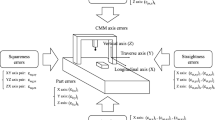Abstract
Uncertainty estimation in coordinate measuring machine (CMM) measurements is one of the highest priority tasks in modern industrial world due to its importance in the manufacturing metrology, especially if we take into account the fact that workpieces, according to a new generation of geometrical product specifications, can be accepted/rejected only on the basis of the total measurement results. Evaluation of measurement uncertainty of a CMM is a complex task, especially in the verification of errors of forms. Among several standard methods that can be used to estimate measurement uncertainty, we performed a comparison between two of these for the case of flatness measurement. Optical flat was used in order to exclude a number of essential factors in the case study. The results showed that the expanded measurement uncertainty assessed by GUM is greater than the value of the expanded measurement uncertainty obtained using the ISO 15530 method. However, both methodologies have shown that the maximum permissible error of a CMM has the greatest impact on uncertainty and also, that the total result evaluated by both approaches is close to the maximum permissible error of a CMM.



Similar content being viewed by others
References
ISO 14253-1:2013 Geometrical Product Specifications (GPS)—Inspection by Measurement of Workpieces and Measuring Equipment—Part 1: Decision Rules for Proving Conformance or Non-conformance with Specifications.
ISO/IEC Guide 98-3:2008 Uncertainty of Measurement—Part 3: Guide to the Expression of Uncertainty in Measurement.
A. Weckenmann, M. Knauer and H. Kunzmann, The Influence of Measurement Strategy on the Uncertainty of CMM-Measurements, CIRP Ann.-Manuf. Technol., 47(1) (1998) 451–454.
S.D. Phillips, B. Borchardt, W.T. Estler and J. Buttress, The Estimation of Measurement Uncertainty of Small Circular Features Measured by Coordinate Measuring Machine, Precis. Eng., 22(3) (1998) 87–97.
J.-P. Kruth, N. Van Gestel, P. Bleys and F. Welkenhuyzen, Uncertainty Determination for CMMs by Monte Carlo Simulation Integrating Feature form Deviations, CIRP Ann.-Manuf. Technol, 58 (2009) 463–466.
K. Iimura, E. Kataoka, M. Ozaki and R. Furutani, The Uncertainty of Parallel Model Coordinate Measuring Machine, MAPAN-J. Metrol. Soc. India, 26(1) (2011) 47–53.
ISO/TS 14253-2:2011 Geometrical Product Specification (GPS)—Inspection by Measurement of Workpieces and Measuring Equipment—Part 2: Guide to the Estimation of Uncertainty in GPS Measurement, in Calibration of Measuring Equipment and in Product Verification.
R.G. Wilhelm, R. Hocken and H. Schwenke, Task Specific Uncertainty in Coordinate Measurement, CIRP Ann.-Manuf. Technol., 50(2) (2001) 553–563.
J. Yang, G. Li, B. Wu et al., Efficient Methods for Evaluating Task-Specific Uncertainty in Laser-Tracking Measurement, MAPAN-J. Metrol. Soc. India, 30(2) (2015) 105–117.
ISO/TS 15530-3:2011. Geometrical Product Specifications (GPS)—Coordinate Measuring Machines (CMM): Technique for Determining the Uncertainty of Measurement—Part 3: Use of Calibrated Workpieces or Standards.
ISO/TS 15530-4:2008. Geometrical Product Specifications (GPS)—Coordinate Measuring Machines (CMM): Technique for Determining the Uncertainty of Measurement—Part 4: Evaluating Task-Specific Measurement Uncertainty Using Simulation.
K. Ostrowska, A. Gaska, R. Kupiec, J. Sladek and K. Gromczak, Verification of Articulated Arm Coordinate Measuring Machines Accuracy Using Laser Tracer System as Standard of Length, MAPAN-J. Metrol. Soc. India. doi:10.1007/s12647-016-0176-2.
ISO 10360-2–2009. Geometric Characteristics of Articles (GPS). Acceptance Tests and Duplicate Check Tests of Coordinate Measuring Machines. Part 2. Coordinate Measuring Machines for Determination of Dimensions.
H.-T. Yao, Uncertainty Analysis in Geometric Best Fit, Int. J. Mach. Tools Manuf., 38(10–11) (1998) 1323–1342.
C. Cui, S. Fu and F. Huang, Research on the Uncertainties from Different form Error Evaluation Methods by CMM Sampling, Int. J. Adv. Manuf. Technol., 43 (2009) 136–145.
J.X. Wang, X. Jiang, L.M. Ma, Z.G. Xu, Z. Li and X. Jiang, Decision Rules for Workpieces Based on Total Uncertainty, Int. J. Adv. Manuf. Technol., 28 (2006) 1169–1174.
R. Raghunandan and P. Venkateswara Rao, Selection of Sampling Points for Accurate Evaluation of Flatness Error Using Coordinate Measuring Machine, J. Mater. Process. Technol., 202 (2008) 240–245.
M. Hadžistević, B. Štrbac, V. Spasić Jokić, M. Delić, M. Sekulić and J. Hodolič, Factors of Estimating Flatness Error as a Surface Requirement of Exploitation, Metallurgy, 54(1) (2015) 239–242.
R. Raghunandan and P. Venkateswara Rao, Selection of an Optimum Sample Size for Flatness Error Estimation While Using Coordinate Measuring Machine, Int. J. Mach. Tools Manuf., 47 (2007) 477–482.
W. Choi, T.R. Kurfess and J. Caganet, Sampling Uncertainty in Coordinate Measurement Data Analysis, Precis. Eng., 22 (1998) 153–163.
X.L. Wen, X.C. Zhu, Y.B. Zhao, D.X. Wang and F.L. Wang, Flatness Error Evaluation and Verification Based on New Generation Geometrical Product Specification (GPS), Precis. Eng., 36 (2012) 70–76.
F. Ricci, P.J. Scott and X. Jiang, A Categorical Model for Uncertainty and Cost Management Within the Geometrical Product Specification (GPS) Framework, Precis. Eng, 37, (2013) 265–274.
ISO 1101:2012 Geometrical Product Specifications (GPS)—Geometrical Tolerancing—Tolerances of Form, Orientation, Location and Run-Out.
V. Radlovački, M. Hadžistević, B. Štrbac, M. Delić and B. Kamberović, Evaluating Minimum Zone Flatness Error Using New Method—Bundle of Plains Through One Point, Precis. Eng, 43 (2016) 554–562.
G. Moona, R. Sharma, U. Kiran, and K.P. Chaudhary, Evaluation of Measurement Uncertainty for Absolute Flatness Measurement by Using Fizeau Interferometer with Phase-Shifting Capability, MAPAN-J. Metrol. Soc. India, 29(4) (2014) 261–267.
J. Sladek and A. Gaska, Evaluation of Coordinate Measurement Uncertainty with Use of Virtual Machine Model Based on Monte Carlo Method, Measurement, 45 (2012) 1564–1575.
K. Gromczak, A. Gąska, M. Kowalski, K. Ostrowska, J. Sladek, M. Gruza and P. Gąska, Determination of Validation Threshold for Coordinate Measuring Methods Using a Metrological Compatibility Model, Meas. Sci. Technol. 28(1) (2017) 1–11.
K. Gromczak, A. Gaska, K. Ostrowska, J. Sladek, W. Harmatys, P. Gaska, M. Gruza and M. Kowalski, Validation Model for Coordinate Measuring Methods Based on the Concept of Statistical Consistency Control, Precis. Eng., 45 (2016) 414–422.
Author information
Authors and Affiliations
Corresponding author
Rights and permissions
About this article
Cite this article
Štrbac, B., Radlovački, V., Spasić-Jokić, V. et al. The Difference Between GUM and ISO/TC 15530-3 Method to Evaluate the Measurement Uncertainty of Flatness by a CMM. MAPAN 32, 251–257 (2017). https://doi.org/10.1007/s12647-017-0227-3
Received:
Accepted:
Published:
Issue Date:
DOI: https://doi.org/10.1007/s12647-017-0227-3




